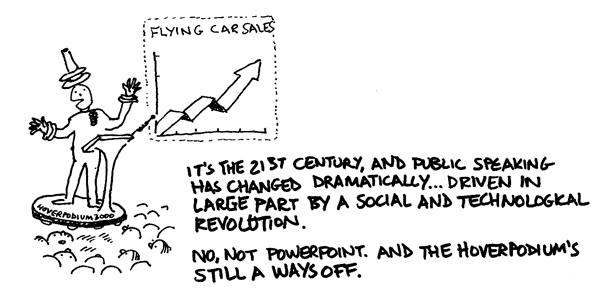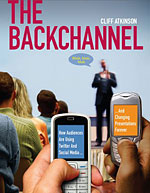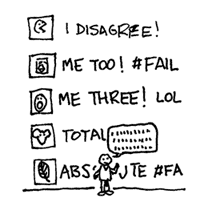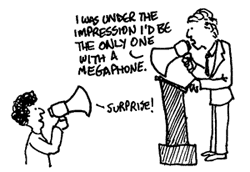- Home
- Blogs
- Rob Cottingham's blog
- Book Review: "The Backchannel"
Public speakers, Cliff Atkinson has your back... channelBook Review: "The Backchannel"
- 10 February, 2010
- 2 comments
 Just as newspapers are scrambling to adjust to a world of blogs and YouTube, speakers are suddenly discovering they're not the only ones in the room who have a microphone. Tools like Twitter and wireless connectivity have broken the monopoly of the speech on, well, speech.
Just as newspapers are scrambling to adjust to a world of blogs and YouTube, speakers are suddenly discovering they're not the only ones in the room who have a microphone. Tools like Twitter and wireless connectivity have broken the monopoly of the speech on, well, speech.
While a presenter is at the front of the room clicking through PowerPoint slides, audience members are talking back - and talking to each other. Speeches are becoming conversations, with the emergence of what's become known as the backchannel.
 That's also the title of a new book by Cliff Atkinson. His previous book, Beyond Bullet Points, helped power a movement away from text-heavy slideshows where the speaker served mainly as a narrator, and toward more engaging presentations supported, not governed, by PowerPoint.
That's also the title of a new book by Cliff Atkinson. His previous book, Beyond Bullet Points, helped power a movement away from text-heavy slideshows where the speaker served mainly as a narrator, and toward more engaging presentations supported, not governed, by PowerPoint.
That positions him well to help speakers cope with this new, digitally-enabled virtual note-passing, and The Backchannel does that well. He blends well-told stories (and a few cautionary tales) from key moments in the backchannel's development with solid, practical advice for speakers who want to join the conversation - as well as event organizers who want to make that conversation as productive as possible. And the technical know-how Atkinson offers - such as an introduction to Twitter and a discussion of tools for monitoring backchannel conversations - is solid.
More importantly, this isn't an evangelical tract. While Atkinson is certainly preaching from the gospel of conversation, he isn't religious about the technology. He does a good job of honestly portraying the backchannel's warts as well as its wonders, and doesn't shy away from stories of notorious trainwrecks. He recommends against the increasingly-common practice of projecting the backchannel onscreen during a presentation, with rare exceptions; It distracts from the presentation, and interferes with the speaker's rapport with the audience. Better instead to have someone monitoring the backchannel and pulling out questions for the speaker to answer during periodic Twitter breaks.

But for a book of relatively few pages, he has some larger ambitions - and that's where The Backchannel really soars. Atkinson is trying to do much more than just help you keep your head above water. He wants to transform you as a speaker, just as audiences are changing: from his call to solicit audience input before the event, to his suggestions for ongoing relationships with your audience.
The single most valuable part of The Backchannel, for my money, is Atkinson's concept of a presentation home page: a conversational hub to house your slides (if any), video or audio recordings, relevant blog posts, links to supporting material, supplements and elaborations on your speech's content, and of course the transcript of the backchannel itself. He delivers not just a description of each section but a wireframe that any moderately skilled web-head should be able to implement - and that wireframe alone is worth the purchase price.
Early in the book, Atkinson suggests you should see your presentation as just one piece of a larger picture: the comprehensive message you want to bring to the world. With his presentation home page, you can begin to see that picture take shape - and for any speaker who wants to make an impact in the world, that's an exciting prospect.
And that puts the rest of the book into perspective. Some of Atkinson's advice, like making your presentation Twitter-friendly by boiling it down to a few pithy key messages, might seem at first like a call to dumb down speeches. (Given the rap on Twitter as an empty, meaningless medium, that charge is probably inevitable.) But simple messages make for better speeches, period; a complicated, lengthy argument just doesn't fly in the spoken word. If that doesn't work for your speech, you have to ask yourself if you've picked the right medium.
 The conversational nature of the backchannel tends to enforce a discipline that makes us better speakers. What's more, as speeches become conversations, their success no longer rests solely on the shoulders of whoever's behind the mike; the medium is becoming collaborative. Maybe that can go some way to making public speaking less scary - both for the speakers who have to deliver presentations, and the audiences that have to sit through them.
The conversational nature of the backchannel tends to enforce a discipline that makes us better speakers. What's more, as speeches become conversations, their success no longer rests solely on the shoulders of whoever's behind the mike; the medium is becoming collaborative. Maybe that can go some way to making public speaking less scary - both for the speakers who have to deliver presentations, and the audiences that have to sit through them.
Speaking is already changing, driven by the same forces that gave rise to the social media revolution. The traditional model of a few voices broadcasting to the multitude - whether from a printing press or a podium - is falling apart.
The Backchannel's model may not be the one that ultimately emerges from the tacit negotiation now underway between audiences and speakers. But it's a great starting point - and a huge advance on the current state of the art, at a time when speakers and audiences alike badly need it.



Comments
Charlotte Britton says
Completely agree this is an outstanding book. For me it was thinking about the presentation as one piece of the jigsaw when presenting or facilitating. Planning, moderating and facilitating the backchannel can lead to a far more fulfiling and interactive session. Gone of the days of being powerpointed to death.....bring on the backchannel and make it mainstream!
Rob Cottingham says
Absolutely - I love the idea that your presentation is only one part of a larger whole. It's strategic in the best sense of the word.